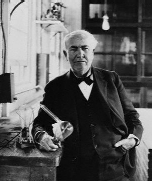 |
 |
| A virtual coffeehouse for
technological minds and ideas |
|
The secret to success at invention…and life
Thomas Edison didn’t conceive the idea of an electric incandescent lamp. Theoretical designs had already existed on paper for many years. The problem was that no filament material was known to exist that could withstand the temperatures necessary for incandescence without being destroyed during operation. Solving this problem was the challenge that Edison eagerly embraced. Why did he succeed at this when so many others had failed? He had almost no formal education. Most all of what he knew came from reading on his own and tinkering with whatever he could get his hands on. He didn’t come from a rich family and didn’t have the financial and experimental resources that many other inventors had to work with. He did have a marvelous mechanical aptitude, but more importantly, he had a determination to succeed that made him see difficulty and failure in a different way than most others did. Because of this difference in vision he persisted beyond the limits where other inventors gave up or decided that their goal was impossible. The failure of a tested design to Edison was not a failure at all. It was merely the acquisition of new knowledge of what wouldn’t work and a step closer to discovering the design that would. During experimental work on a more practical and efficient storage battery a very discouraged member of Edison’s staff confronted him with the news that one thousand different chemical combinations had been tried and had all failed, and wondered if they should give up the pursuit. Thomas Edison merely replied that it meant a thousand less to go and to keep working. This characteristic is not unique to Mr. Edison. There are many more examples, such as Jeff Bezos of Amazon.com. For several years after starting the company in 1994 Amazon was losing money. I remember reading the tech and business articles suggesting that Bezos had bet on an unworkable idea and making predictions of how much longer he could last before having to declare failure. Some analysts almost seemed to delight in anticipating the impending end to this man’s foolish dream. Throughout all of it Jeff Bezos never expressed anything other than total confidence in his plan, and continued to do whatever it took to see it through. He was right and they were wrong because he looked beyond the difficulty and saw success, and several years later he achieved it in great abundance. I have always been fascinated in learning why the most successful people have been able to achieve their success when so many more fail at this same attempt. Sure, skill and resources often play a part, but the single-most common factor that I’ve discovered is that they all see difficulties and obstacles not as barriers to success but as doorways to it. They persist at the point where others quit, and thereby continue on to realize their goals. P.H. |
add to favorites
|
 del.icio.us
del.icio.us
 Slashdot It!
Slashdot It!
 Stumble It!
Stumble It!
Home | About Us | Advertise | Submit an Article | Submit a Link | Contact Us
ElectronCafé.com is a registered property of electricalfun.com Copyright © 2008 - All rights reserved
 Whispers of discontent were growing at the Menlo Park laboratory, just
beyond detection of the master’s nearly deaf ears. The workers
were still getting paid, but would the money run out? Maybe
there was a reason that nobody else had made a working light
bulb… Maybe it just couldn’t be done. That was the opinion of
many of the prominent and educated scientists and engineers at
the time.
Whispers of discontent were growing at the Menlo Park laboratory, just
beyond detection of the master’s nearly deaf ears. The workers
were still getting paid, but would the money run out? Maybe
there was a reason that nobody else had made a working light
bulb… Maybe it just couldn’t be done. That was the opinion of
many of the prominent and educated scientists and engineers at
the time.